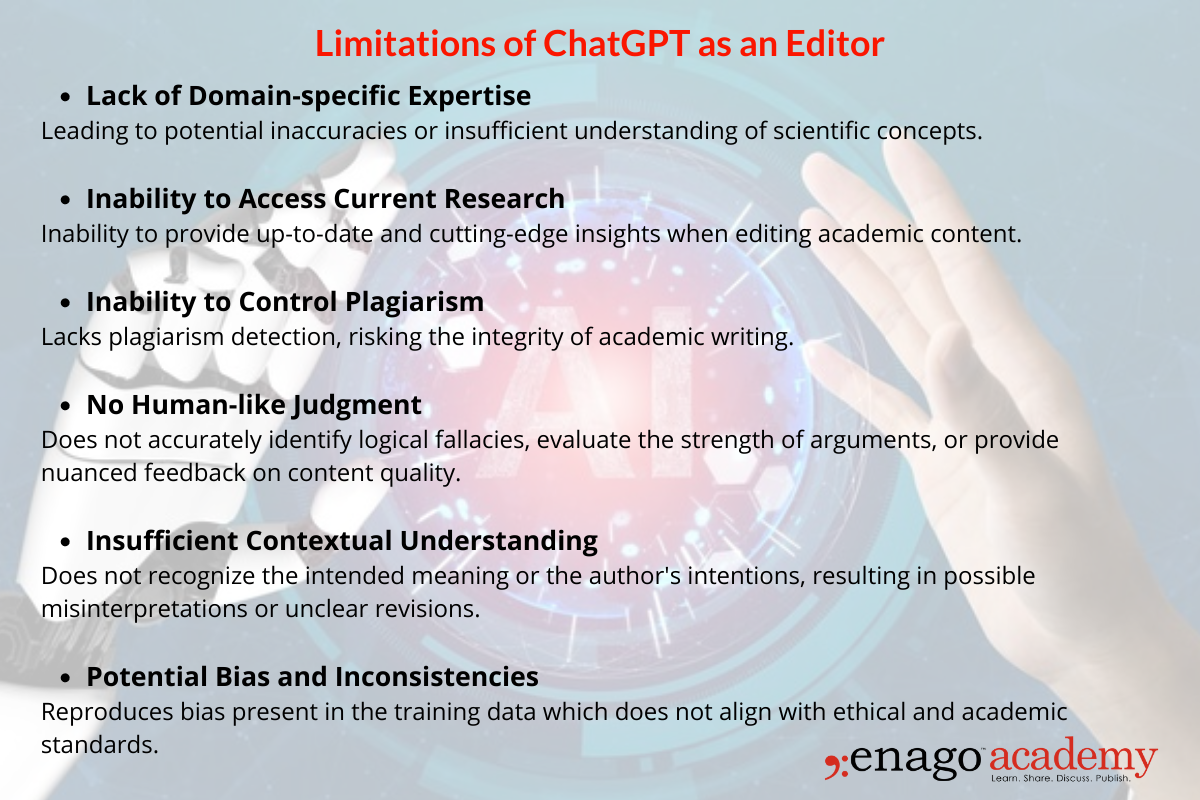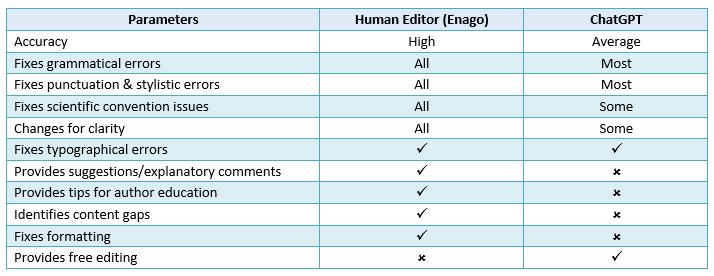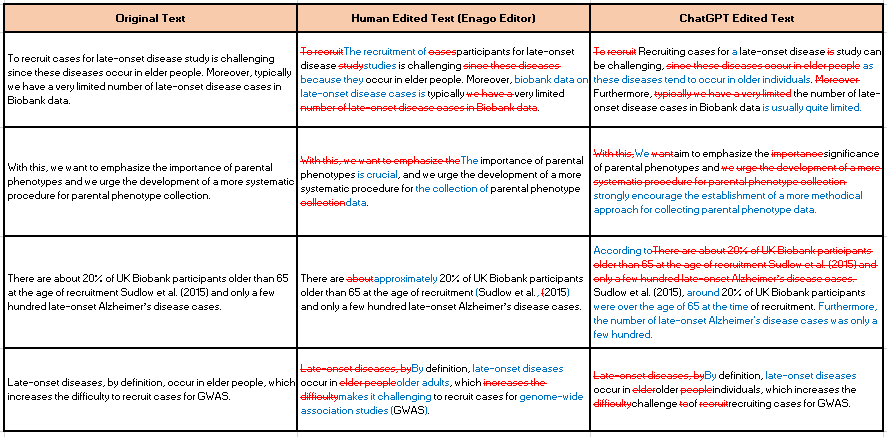Human Editors or ChatGPT — What should you use for reliable publication-ready work?

Using ChatGPT to edit your manuscript is potentially wracking your academic reputation, and how!
- ChatGPT is an absolute champion at disregarding proper citation and referencing. Who needs to acknowledge sources and give credit where it’s due when you have an AI language model that blissfully ignores all those pesky academic conventions? Goodbye, academic integrity!
- Let’s not forget ChatGPT’s remarkable ability to provide completely outdated information. Who needs the latest research and cutting-edge insights when you can rely on a knowledge cutoff from 2021? It’s like having a time-traveling scholar from the past, but without any of the wisdom from actual references.
- It’s probably just a tool that is summarizing all the data openly accessible on the Internet, which is supposedly illegally sourced by OpenAI and presenting to you in a slightly different way.
- Speaking of the nuanced understanding of discipline-specific requirements? ChatGPT is blissfully ignorant. Whether it’s the distinctive style, tone, or even the fundamental principles of a field, rest assured that ChatGPT will produce content that is absolutely devoid of any disciplinary knowledge.
If you are still using ChatGPT to edit your scholarly work, remember that its inability to comprehend the underlying meaning and intentions of an author’s work is truly remarkable too. Say goodbye to those personal voices and unique writing styles, because ChatGPT will transform every piece into a generic, soulless creation. Who needs individuality and intellectual identity, anyway right?
These aren’t opinion-based claims but what I have experienced as a scholarly writer myself. Here are 2 examples that clearly show how ChatGPT is an absolute disaster when it comes to scholarly work editing and how human editors are the only way to ensure efficient and error-free scholarly editing.
ChatGPT vs Human Editing
Example 1-
Original Text

Edited by ChatGPT

Edited by a Human (Enago Editor)

ChatGPT misinterpreted DNP to be an amino acid instead of diabetic nephrophathy and introduced a critical meaning change in the sentence. Whereas, the human editor ensured correct usage of the discipline-specific term without changing the narrative.
Example 2-
Original Text

Edited by ChatGPT
 Edited by a Human (Enago Editor)
Edited by a Human (Enago Editor)

Error Explanation
ChatGPT almost rewrote the text and added some new text that was not present in the original statement. The author’s voice is changed in this case and adding of redundant information may change the intended context of the author. However, the human editor ensured that the text is edited in a manner that keeps the author’s voice intact and conveys the right information without adding superfluous text.
What’s your hard work on the research worth if it is not relayed in the correct way?
Additionally, with its vast training data derived from the web, ChatGPT magnifies the biases that exist in society, inadvertently turning your academic work into a biased, one-sided narrative. Critical analysis are at bay when ChatGPT reinforces the pre-existing beliefs of the society?
Sure, it is quick (but not efficient), free for now (but would cost you your reputation), consistent (but monotonous), scalable (but who’s willing to risk their business decions on an AI model that is probably prone to several lawsuits?).
It is anyway not doing the job right. So it devoids us from thinking that it will replace human editors. Again, not an opinion and the importance of human text editing cannot be overstated! Here are the facts that validate how human editors are indispensable when it comes to scholarly work.
Let’s explore some of the crucial aspects of human editing.
The Expertise that Human Editors Bring
Although generative AI tools such as ChatGPT become easily accessible, human text editing holds a crucial place in several industries including academic publishing. Here’s why!
1. Contextual Understanding
Human editors can use their knowledge and experience to determine the intended meaning behind the words, and make changes accordingly. This ensures that the text is not only grammatically correct but also conveys the intended message accurately.
2. Ability to Detect Subtle Nuances
Human text editors are trained and capable of identifying subtle nuances in the text, such as tone and style, that ChatGPT or other AI-powered tools tend to miss. They can use their experience and intuition to ensure that the text sounds natural and flows well, making it easier for the reader to understand. This is especially important in creative writing, where the tone and style are essential to the overall effect of the piece.
3. Creative Problem-solving
Human text editors are skilled at creative problem-solving, which is essential in certain industries such as marketing and advertising. They can identify and address issues that AI-powered tools may miss, such as inconsistencies in brand messaging or lack of clarity in communication. Human editors can also suggest creative solutions to problems, such as rewriting copy to make it more engaging or impactful.
Limitations of ChatGPT and Other AI Tools as Editors
While AI-powered text editing tools offer several benefits, they also have some critical limitations that must be taken into consideration. Here we focus on limitations with academic or scholarly text.
 1. Lack of Domain-specific Expertise
1. Lack of Domain-specific Expertise
Academic writing often requires a deep understanding of subject-specific terminology, theories, methodologies, and current research trends. Without domain-specific expertise, ChatGPT may struggle to accurately comprehend the nuances and intricacies of specialized topics. It might not recognize important contextual cues or grasp the underlying assumptions and implications specific to a particular field.
For instance, in technical or scientific disciplines, the accuracy and precise use of terminology are critical. A minor misinterpretation or misuse of a term can significantly impact the meaning of a sentence or paragraph. Since ChatGPT lacks the ability to discern such nuances without prior exposure to field-specific knowledge, it may inadvertently introduce errors or provide misleading suggestions during the editing process.
Moreover, complex scientific concepts often require a deep understanding of foundational principles, empirical evidence, and theoretical frameworks. ChatGPT may lack the capacity to critically analyze the validity or significance of scientific claims. It might not recognize flawed reasoning, logical fallacies, or subtle flaws in the argumentation presented in the text.
Relying solely on ChatGPT’s recommendations without cross-referencing with domain experts or consulting specialized literature can risk the introduction of errors or misinterpretations.
2. Inability to Access Current Research
ChatGPT has a knowledge cutoff date that corresponds to the time at which it was last trained, and its database does not automatically update with the latest scientific publications and advancements. Consequently, ChatGPT may not be equipped with the most up-to-date information when editing academic content.
In the rapidly evolving landscape of scientific research, new studies, findings, and breakthroughs are constantly emerging. Staying abreast of these developments is crucial for maintaining the currency and relevance of academic work. However, since ChatGPT’s training data is static, it may lack familiarity with the latest research publications, methodologies, or advancements in various fields.
This limitation can hinder ChatGPT’s ability to provide cutting-edge insights or suggest revisions based on the most recent scientific knowledge. It might overlook recent studies that challenge or update established theories or fail to incorporate the latest experimental techniques and methodologies.
Authors relying solely on ChatGPT for academic editing should be aware of this limitation and consider supplementing its suggestions with their own literature review or consulting subject matter experts. Human editors independently verify the accuracy and currency of the information presented in academic papers, ensuring that the content reflects the latest advancements in the field.
3. Inability to Control Plagiarism
Plagiarism is a serious issue in academic and research writing, as it undermines the integrity of the work and can lead to severe consequences, such as rejection of the manuscript, loss of credibility, and legal action. While ChatGPT has the ability to generate text based on the input provided by the user, it does not have the capability to compare the text with other sources to check for similarity or plagiarism. Being a language model, ChatGPTrelies on statistical patterns in large amounts of text data to generate responses, rather than a plagiarism detection tool that compares the text with other sources to check for matches.
Hence, if a user relies solely on ChatGPT for editing their research writing, they run the risk of inadvertently including plagiarized content in their work. This can have serious consequences, not only for the user but also for the reputation of the institution they are affiliated with.
Therefore, it is important for users to supplement the use of ChatGPT with other tools and techniques for detecting plagiarism, such as manual checking, using plagiarism detection software, and adhering to proper citation and attribution practices. While ChatGPT can be a useful tool for editing and improving the quality of the text, it should not be relied upon as the sole means of ensuring the integrity of research writing.
4. No Human-like Judgment
Unlike an experienced human editor, ChatGPT may not possess the same level of discernment and nuanced understanding of content quality.
Identifying logical fallacies and evaluating the strength of arguments requires more than just language processing capabilities. It involves the ability to assess the validity and coherence of ideas, consider counterarguments, and weigh the evidence presented. While ChatGPT can provide suggestions for improving clarity and coherence, it may not have the capacity to spot subtle flaws in reasoning or recognize nuanced logical fallacies.
Furthermore, content quality in academic writing extends beyond mere grammar and structure. It involves the clarity of ideas, the organization of information, the appropriateness of evidence, and the adherence to scholarly standards. While ChatGPT can help enhance the overall flow and readability of a text, it may not be able to provide comprehensive feedback on these broader aspects of content quality.
Authors should be cautious about ChatGPT’s suggestions for evaluating the strength of arguments or the overall quality of their academic work. It is crucial to complement its assistance with independent critical thinking and review processes. Seeking input from human editors can provide valuable insights and ensure the rigor and integrity of the content.
By recognizing the limitations of ChatGPT in terms of human-like judgment, authors can make informed decisions about the level of reliance they place on the model’s suggestions. Employing a collaborative approach that combines the strengths of ChatGPT with human expertise can lead to more robust and comprehensive academic editing.
5. Insufficient Contextual Understanding
One notable limitation of ChatGPT and other AI text editors is their potential for insufficient contextual understanding. Their struggle to fully comprehend the nuanced context in which the text is being used can lead to inappropriate or incorrect editing suggestions.
One common example involves homophones, words that sound the same but have different meanings and spellings. For instance, consider the words “their” and “there.” Although both words may be spelled correctly, the AI text editor might not recognize the intended meaning in a specific sentence. Consequently, it may propose corrections or replacements that are contextually incorrect, resulting in potential errors or a change in the intended message.
In addition to homophones, ChatGPT may struggle with other contextual nuances, such as idiomatic expressions, cultural references, or domain-specific terminology. It may not possess the necessary cultural or subject-specific knowledge to accurately interpret such elements in the text, leading to potential misinterpretations or inappropriate suggestions.
Authors should consider whether the proposed edits align with the intended meaning and context of their work. It is crucial to review and revise the text with the help of a human editor, taking into account the specific nuances and subtleties that AI tools may overlook.
Human editors provide valuable insights and ensure that the text is accurately aligned with the intended meaning and context, enhancing the overall quality of the academic writing.
6. Potential Bias and Inconsistencies
An important consideration when using ChatGPT as an academic editor is the potential for bias and inconsistencies in the suggested edits. ChatGPT is trained on extensive amounts of text data, which can include biases and prejudices present in the training material. As a result, there is a risk that the model may inadvertently reproduce or reinforce these biases in its suggestions.
Bias can manifest in various forms, including but not limited to gender, race, culture, or ideology. For example, ChatGPT may inadvertently propose gender-specific language or exhibit cultural insensitivity due to biased representations in the training data. Such biases can perpetuate stereotypes or result in discriminatory language choices.
To ensure the integrity and fairness of academic writing, it is crucial for authors to critically assess and verify the suggested edits provided by ChatGPT. It is essential to review the edits through the lens of ethical and academic standards, considering the potential biases that may be present. Authors should be vigilant in identifying and correcting any biased language or content that may have been inadvertently introduced.
Additionally, inconsistencies can arise in the suggestions provided by ChatGPT due to the vast amount of training data it has been exposed to. Different writing styles, preferences, or conventions may exist within the training data, leading to varied or conflicting suggestions. Authors should exercise their judgment in selecting the most appropriate revisions and ensure consistency throughout their work.
Mitigating the impact of bias and addressing inconsistencies requires a thoughtful and critical approach. Authors should actively engage in reviewing and revising the suggested edits, independently verifying the accuracy, fairness, and alignment with ethical and academic principles. Collaborating with human editors or peers can provide valuable perspectives and assist in identifying and rectifying any biases or inconsistencies.
By remaining cognizant of the potential bias and inconsistencies in AI-generated suggestions, authors can take necessary precautions to ensure their work upholds the standards of fairness, objectivity, and inclusivity required in academic writing.
Summarized Comparison Between ChatGPT and Human Editor
A. Contextual and Relevant Editing
ChatGPT offers several strengths including its ability to quickly identify and correct errors, consistency in editing, and scalability. It can analyze large datasets of text and learn from them, improving its editing capabilities over time. However, it has limitations such as the inability to understand the nuances of language and context, and susceptibility to generating incorrect or irrelevant editing suggestions.
Human text editing has its strengths, including the ability to understand context, detect subtle nuances in language, and make judgment calls based on tone and intent. Human editors can also bring creativity and flexibility to the editing process, adapting their approach based on the specific needs of each text. However, human text editing is time-consuming and subject to human error and bias.
But as a researcher whose scholarly work will be referred by several other researchers, you should rather be slow than wrong!
B. Suitability for Different Types of Texts and Contexts
The suitability of ChatGPT and human text editing varies based on the type of text and the context in which it is used. When it comes to research and scholarly text, the suitability of ChatGPT and human text editing depends on several factors. Research and scholarly text often require a high degree of accuracy, clarity, and coherence, which are essential for effective communication and knowledge transfer. ChatGPT text editing is well-suited for standardized texts, such as research papers, technical manuals, or legal documents, where consistency and accuracy are essential.
Researchers can use ChatGPT to generate an initial draft, which can then be further refined and improved through human editing and revision. However, it is important to note that ChatGPT text editing may not be appropriate for certain types of scholarly text, such as those that require critical analysis or interpretation. For instance, in literature or humanities research, where the interpretation and analysis of complex texts are essential, human text editing may be more appropriate. Similarly, in qualitative research, where the researcher’s interpretation of data is critical, human text editing may be more effective in capturing the nuances and complexity of the research findings.
Human text editing, on the other hand, is better suited for all types of texts, including creative or subjective texts, where the tone and intent of the text are crucial. In addition to tone and style, human text editing is also critical in ensuring that the content of the text is accurate and well-supported, especially for research and scholarly writing. This involves fact-checking, verifying sources, and ensuring that the arguments presented in the text are logical and well-structured. In scholarly writing, human editors can help ensure that the writer’s argument is clear, consistent, and supported by rigorous evidence. This can involve reviewing data, conducting literature reviews, and helping the author to articulate their research question and methodology effectively.
Examples of Human Editing vs ChatGPT Editing
Which Is Better — Human or ChatGPT Text Editing?
Human editors, of course!
After careful consideration, it is evident that human editors are better and more reliable than ChatGPT. This conclusion is grounded in a multitude of compelling reasons.
The human editor’s innate cognitive faculties of creativity and critical thinking far surpass that of its AI counterpart, ChatGPT. These faculties enable human editors to not only detect and rectify errors in grammar and syntax but also to suggest alternative phrasing, restructure sentences, and adjust tone and voice to fit the intended audience more effectively than ChatGPT and other AI tools. The intricate thought process and nuanced perspective that human editors bring to the table while upholding the author’s voice and guiding them with constructive suggestions are irreproducible by ChatGPT or any other AI tool.
Additionally, human editors possess the exceptional ability to contextualize and interpret meaning, a skill that ChatGPT or any other AI tool cannot replicate. Although AI tools, including ChatGPT may have access to vast databases and language patterns, they are fundamentally incapable of comprehending the meaning behind a given piece of text. On the other hand, human editors readily recognize the context of the text, the intended audience, and the underlying message being conveyed. This understanding empowers human editors to ensure that the text not only conforms to grammatical standards but also achieves coherence and meaningfulness.
Moreover, human editors possess a level of adaptability and intuition that ChatGPT and other AI tools lack. While these tools may have some capacity for adjusting their suggestions to different writing styles, they lack the flexibility and nuanced judgment that human editors possess. Human editors can tailor their editing style to the specific requirements of the journal or client, whether it is formal or informal, technical or creative. They make decisions based on the author’s style and voice, rather than simply applying a set of pre-programmed rules.
Finally, human editors offer a wealth of valuable feedback and insights to the author. While ChatGPT and other AI tools may be capable of providing suggestions, they cannot offer the personalized feedback and advice that human editors can. Human editors provide constructive criticism, elucidate their reasoning, and provide guidance on how to improve the text. They also offer insights into the publishing industry, trends in language usage, and other useful tips that ChatGPT and other AI tools cannot match.
Thus, while AI tools such as ChatGPT may have their merits in specific circumstances, they cannot supplant the skills and intuition of human editors. Human editors bring creativity, critical thinking, context, adaptability, and feedback that no AI tools can match. As long as language remains a complex and nuanced tool of communication, human editors will continue to play a crucial role in ensuring that written works achieve the highest possible quality.









